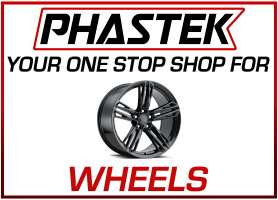
Curing Camaro Wheel Hop
This article was written by our friends at “The Horsepower Junkies”
(reprinted with permission)

All the horsepower in the world will not make your car faster if it can not transfer that power to the pavement. 5th generation Camaro SS owners, especially those with cars that are extensively modified, are quickly learning this due to the dreaded “wheel hop”. Wheel hop is a violent and potentially damaging condition that typically occurs when the car is launched aggressively and has been described as feeling like the rear tires are driving rapidly over rail road ties. It is very simply a rapid and repeated loss and recovery of traction.
When a car begins to accelerate various bushings and suspension/chassis components deflect. Under normal driving conditions this flexing is negligible but when the car is launched aggressively the deflection causes significant toe changes which reduce the contact patch of the rear tires. This leads to a reduction in traction and momentary wheel slippage which alleviates the toe changes and allows the rear tires to regrip. The vicious circle then continues as the suddenly improved traction again results in deflection and toe changes leading to wheel slippage. The frequency of the cycle is so rapid that it feels like the rear of the car is riding on jack hammers.
The Fix
Getting rid of wheel hop is pretty easy for most Camaro SS owners. It is all about limiting the movement of the rear tires in relation to the chassis under acceleration. We have found that a good set of rear trailing arms are many times all it takes for the average bolt on car. These aftermarket components are usually lighter and stronger than the OEM units they replace and allow the rear suspension to respond more quickly and keep the rear tires in contact with the pavement, thus increasing traction. They also replace the stock mushy rubber bushings with stiffer polyurethane units that help reduce deflection.
For more extensively modified cars or those that are more track oriented it may be necessary to lock in the rear sub frame. This is accomplished with an rear sub frame bushing upgrade. These bushings are much stiffer than the stock units and minimize or even eliminate sub frame movement. Most vendors currently offer these bushings in polyurethane but Pfadt Race Engineering offers an excellent solid sub frame bushing machined from aluminum.
While the rear sub frame bushings are being upgraded it is a great opportunity to also upgrade the rear differential bushings. The units help with wheel hop and traction issues while contributing to an overall reduction in drive train deflection which will help more horsepower get to the pavement more quickly.
In some cases, usually very high powered cars or those used very heavily at track, a third step may be necessary. Rear toe rods set the rear wheels in a fixed position and resist any remaining deflection. Depending on what parts you select, taking this step can create a solid connection that will transmit road noise into the chassis. Daily drivers need to make sure they do their homework and consult a knowledgeable vendor.
Below is a video filmed by Pfadt Race Engineering that demonstrates the reduction in deflection that is realized by installing their Rear Trailing Arms and Solid Sub Frame bushings.









Facebook
Twitter
Instagram
YouTube
RSS